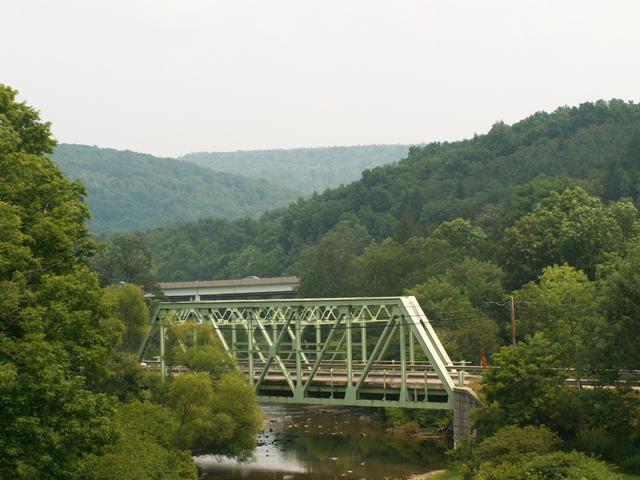We Recommend:
Bach Steel - Experts at historic truss bridge restoration.
BridgeHunter.com Phase 1 is released to the public! - Visit Now
Grantsville Bridge

Primary Photographer(s): Nathan Holth and Rick McOmber
Bridge Documented: July 1, 2006 and July 6, 2014
2008
133.0 Feet (40.5 Meters)
137.0 Feet (41.8 Meters)
40 Feet (12.19 Meters)
1 Main Span(s)
100000110007010

View Information About HSR Ratings
Bridge Documentation
View Archived National Bridge Inventory Report - Has Additional Details and Evaluation
View The Historic Bridge Inventory Report For This Bridge
This bridge is a beautiful historic companion to the even older and more significant Casselman Bridge. Indeed the views of the Grantsville Bridge from the Casselman Bridge are spectacular, with the ugly, modern I-68 Bridge being the only scar on an otherwise pristine calendar-photo-quality landscape of historic bridge and mountains.
The truss bridge is an excellent representation of the standard plan design that Maryland employed for truss bridges in the 1930s. During the first half of the 20th century, states designed standard plans for bridges. It is often interesting to compare the designs that each state created for their truss bridges. Maryland's design appears to feature a wider deck than other states employed, unless this bridge was originally designed to accommodate more lanes of traffic than the two it holds today. Wide shoulders are present on the bridge. The Maryland design features extensive use of rolled beams as opposed to built-up members, giving the structure a more plain appearance than similar bridges in other states. Only the chords and some parts of the sway bracing are built-up. V-lacing occurs on the sway bracing beams, while lattice is on the underside of the top chord and end post box beams. The bottom chord sections are connected via battens. The Grantsville Bridge is also a skewed example of the design. Pole railings appear to be the original railings that remain on the bridge, while modern Armco style railings appear below those.
This bridge is locally significant as the last truss bridge remaining in the county, at least on public highways. There was apparently a pin-connected truss bridge near this bridge on River Road, but that apparently does not exist anymore. Given this fact, as well as the fact that the bridge is plenty wide for a modern highway, the preservation of this bridge for continued vehicular use in place seems a worthy cause.
This bridge is listed on Maryland's Historical Trust website as a state-identified historic place.
One interesting observation on this bridge is that the paint system is showing rust on the threads of the (non-original) bolts on the bridge. Perhaps the sharp edges of bolts develop rust quicker than the smooth round heads of rivets. Perhaps if historically correct rivets were used in rehabilitation a longer paint service life might also be achieved.
This bridge is tagged with the following special condition(s): Unorganized Photos
![]()
Photo Galleries and Videos: Grantsville Bridge
Bridge Photo-Documentation
A supplemental collection of photos that are from additional visit(s) to the bridge and have not been organized or captioned. This photo gallery contains a combination of Original Size photos and Mobile Optimized photos in a touch-friendly popup viewer.Alternatively, Browse Without Using Viewer
![]()
2014 Additional Unorganized Photos
Original / Full Size PhotosA supplemental collection of photos that are from additional visit(s) to the bridge and have not been organized or captioned. This gallery offers photos in the highest available resolution and file size in a touch-friendly popup viewer.
Alternatively, Browse Without Using Viewer
![]()
2014 Additional Unorganized Photos
Mobile Optimized PhotosA supplemental collection of photos that are from additional visit(s) to the bridge and have not been organized or captioned. This gallery features data-friendly, fast-loading photos in a touch-friendly popup viewer.
Alternatively, Browse Without Using Viewer
![]()
Maps and Links: Grantsville Bridge
Coordinates (Latitude, Longitude):
Search For Additional Bridge Listings:
Bridgehunter.com: View listed bridges within 0.5 miles (0.8 kilometers) of this bridge.
Bridgehunter.com: View listed bridges within 10 miles (16 kilometers) of this bridge.
Additional Maps:
Google Streetview (If Available)
GeoHack (Additional Links and Coordinates)
Apple Maps (Via DuckDuckGo Search)
Apple Maps (Apple devices only)
Android: Open Location In Your Map or GPS App
Flickr Gallery (Find Nearby Photos)
Wikimedia Commons (Find Nearby Photos)
Directions Via Sygic For Android
Directions Via Sygic For iOS and Android Dolphin Browser
USGS National Map (United States Only)
Historical USGS Topo Maps (United States Only)
Historic Aerials (United States Only)
CalTopo Maps (United States Only)



